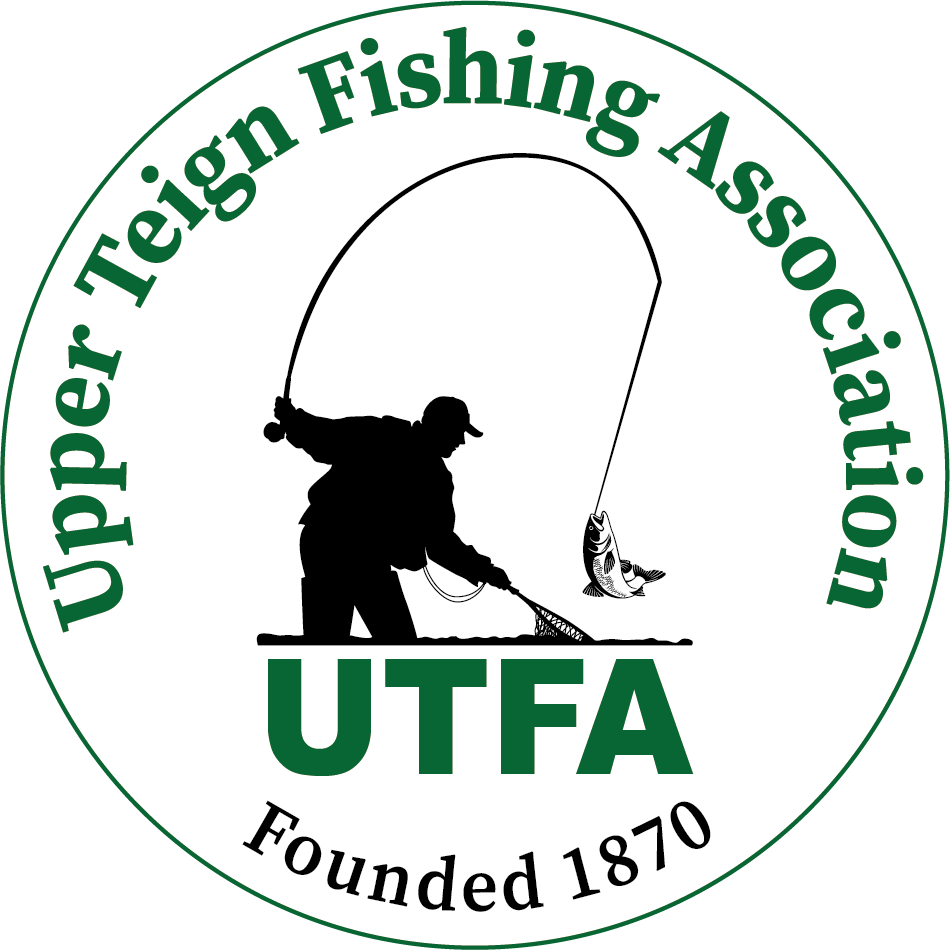FROM TOP TO BOTTOM
The topmost point on the UTFA fishery is at Warcleave Cottage, about a quarter of a mile above Chagford Bridge. From here the river swings around Warcleave Bend and continues through three meadows on the left bank to Chagford Bridge, a stretch that may go a whole season without seeing an angler. There are several good pools, which are certainly worth a try for a late-season salmon, and the whole stretch holds plenty of trout.
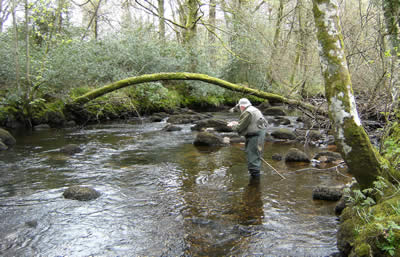
The top of the UTFA fishery at Warcleave Bend
Below Chagford Bridge, the Teign is still a small river but soon broadens out into Chagford Weir Pool, the highest major sea trout pool on the UTFA fishery. Sea trout have usually arrived in this pool in good numbers by late June and the easy access and open fishing spots make it a popular choice for a night-time session through the summer.
From Chagford Weir down to Rushford Bridge there is good if difficult fishing for wild brown trout, the very clear water making it easy to spook the fish. And the bigger pools have all produced salmon after summer floods.

The Stepping Stones at Rushford Mill
Between Rushford Bridge and Mill End (or Dogmarsh) Bridge, the most important sea trout pool is Dogmarsh Weir Pool. This has always been a productive spot for sea trout, although it is quite small with space for only a couple of rods. It is also worth a try for salmon in the right conditions. Rushford Mill Pool, just below Rushford Mill Farm and the stepping stones, was once a popular spot for an hour’s sea trout fishing but seems to have been ignored in recent years – so perhaps the time has come to give it another try. This whole stretch is ideal for wading up the stream with a short rod and a dry fly or nymph for brown trout.
Below Mill End Bridge, the Teign begins to look a bit bigger and there is good brown trout fishing all the way down to the top of Drogo Weir Pool. In the autumn of 2006, coarse woody debris was introduced at various points along this stretch, as part of a Wild Trout Project aimed at improving the size and number of trout. It is hoped that woody debris will provide improved cover for mature trout and increase the habitat for the invertebrates that trout feed on. Drifting a fly alongside these new features could be productive.
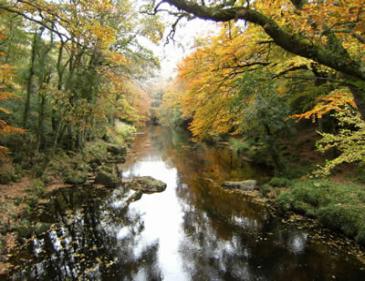
Drogo Weir Pool in late autumn
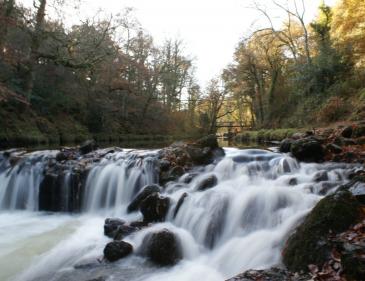
Drogo Weir in early winter
Drogo Weir Pool is one of the most popular night spots on the fishery, with its well-deserved reputation for sea trout catches. The top part of the pool and the fast run in provide some of the most consistent salmon fishing.
Immediately below Drogo Weir Pool there is a short stretch where access can be quite difficult, but is well worth exploring for wild trout, if you are reasonably agile. The river opens up again at Engine House Pool and this is the start of the most popular stretch of brown trout fishing on the fishery. It is between here and Upperton Pool that supplementary stocking with brown trout has been carried out each year since 2003, but even before then this stretch accounted for most of the trout fishing on the upper Teign. Plenty of car parking at Fingle Bridge and easy access both above and below the bridge will always ensure the popularity of this area.
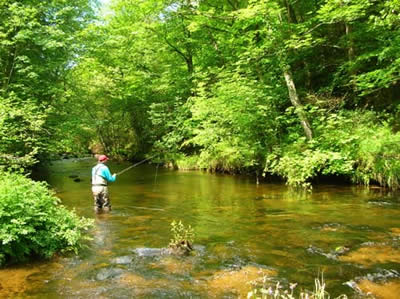
Trout fishing below Daubeney’s Pit
The pools below Sharp Tor can fish well for trout at any time, and their turbulence means that even in high summer they have enough life to be productive, whether with dry fly or nymph. The stretch from Engine House Pool down to Black Pool offers some of the best brown trout fishing on the fishery. For the salmon angler, it is worth exploring any of the pools, with Daubeny’s Pit, Black Pool, Rocky Pool and Fingle Weir Pool among the favourites – the last of these being one of the best sea trout spots.
Stretches of the river above and below Fingle Bridge are popular with visitors and can be very noisy at times. Nevertheless, the stretch alongside the meadow below the bridge has a lovely sequence of runs and pools that are ideal for trout fishing. Although many wait until evening when the crowds have gone, this stretch fishes surprisingly well even when you have to compete with children and dogs. Perhaps the brownies get used to all the disturbance.
From Fingle Bridge down to the top of Upperton Weir Pool there is one good brown trout pool after another. Take a walk down to Ten Beeches and then fish back up to Fingle Bridge for several hours of interesting trout fishing. Trout hot spots along this stretch include Broadmoor Pit, Fallen Tree Pool and Holly Pit.
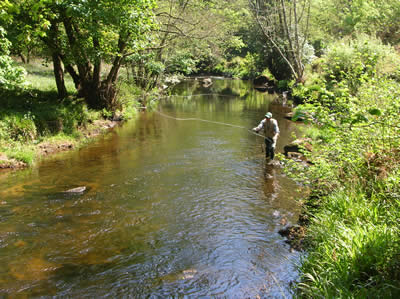
Casting for a trout on Broadmoor Pit
Upperton Weir Pool is the biggest pool on the fishery and probably the most popular for sea trout fishing – especially early in the season, as this is the first major pool to see the sea trout. The fast water at the top of the pool is also worth a try for salmon.
From Upperton Weir down to Clifford Bridge there is a series of pools and pots suitable for salmon fishing. Starting with Rod’s Pot, named after the late Roddy Rae who first realised the potential of this tiny pool, the sequence includes O B Pool, Sycamore Pool, Flow Gauge Pool, Weir Mill Pool, Boar’s Reach and Scotley Brook Pool. The short stretch from Scotley Brook down to Clifford Bridge has some lovely pools and runs for brown trout fishing.
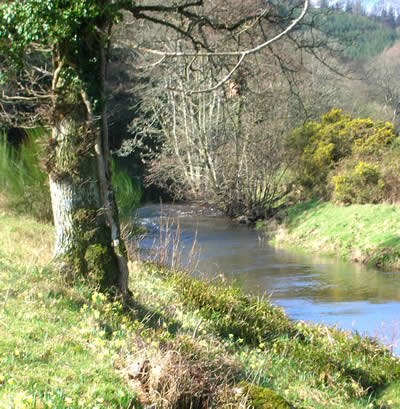
Boar’s Reach, a popular spot for salmon
The bottom part of the UTFA fishery, from Clifford Bridge down to Steps Bridge, is mostly within the Dunsford Nature Reserve, where the early spring flowering of wild daffodils is a great attraction. This is a lengthy stretch but, until you reach Steps Bridge Pool at the bottom of the fishery, the only salmon pool of any consequence is Druid’s Pool, and the long walk to fish one pool means that it is rarely fished for salmon. However, there are several spots along this stretch where trying for a salmon might produce a surprise.
The whole stretch from Clifford Bridge down to the top of Steps Weir Pool is ideal for fly fishing for trout and bank clearing in early 2007 and 2008 has made it even more accessible.
And finally to Steps Weir Pool, the lowest sea trout spot on the fishery. Heavy bank-side growth makes night fishing quite tricky, so this pool provides a challenge for any angler.

Steps Weir – the bottom end of the fishery
From Warcleave to Steps Bridge, the extensive UTFA fishery offers mile after mile of varied water for the brown trout, sea trout or salmon angler – and all of it set in one of the most beautiful valleys in the Dartmoor National Park.

